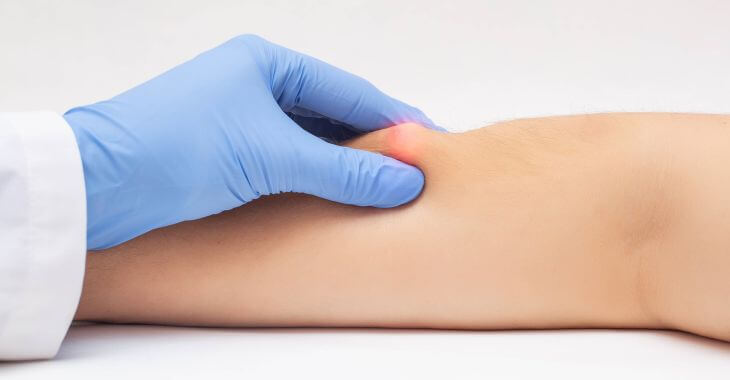Understanding the Differences Between Lipoma vs. Cyst

When you notice a lump under your skin, it’s natural to feel concerned. Two common types of benign growths that can form under the skin are lipomas and cysts. While they may seem similar at first glance, there are important differences between these two types of growths.
Knowing the differences between lipoma vs. cyst can help you understand how to identify these lumps, what causes them, and how they’re treated. In this article, we’ll explore the characteristics of each, what distinguishes them, and when you should seek medical advice.
What Is a Lipoma?
A lipoma is a slow-growing, non-cancerous lump of fatty tissue that forms between the skin and underlying muscle. They tend to be soft, moveable, and painless when touched. Lipomas are typically found in middle-aged adults but can develop at any age.
Characteristics of Lipomas:
- Soft and doughy texture
- Moveable under the skin
- Usually painless
- Ranges from 1 to 3 cm (but can grow larger)
- Slow-growing
Lipomas are generally not harmful, but in rare cases, they can cause discomfort if they press on nearby nerves or muscles. While most lipomas are left untreated, they can be surgically removed if they become bothersome.
Lipomas are often confused with cysts due to their appearance, but they are composed entirely of fatty tissue, whereas cysts have a different makeup.
What Is a Cyst?
A cyst is a sac-like structure that can form anywhere in the body, including on the skin, filled with fluid, pus, or other material. Cysts are usually small, round, and firm to the touch. They can appear on the skin’s surface or deeper within the body.
Characteristics of Cysts:
- Firm or rubbery texture
- Fixed in place under the skin
- Can become tender or painful if infected
- Vary in size (small or large)
- Filled with fluid or other material
Cysts are more likely to become inflamed or infected compared to lipomas. They may cause redness, swelling, and discomfort, particularly if they rupture or become infected. Unlike lipomas, which consist of fat, cysts are enclosed sacs filled with various substances.
Cyst vs Lipoma: Key Differences
Now that you understand the basics of lipoma vs. cyst, let’s take a closer look at how to tell them apart. While they can appear similar, several factors differentiate them:
1. Texture and Movement
Lipomas have a more pliable texture, making them feel like dough when pressed. Cysts, on the other hand, are often firmer and less moveable, especially when they are deeper under the skin.
- Lipomas: Soft and easily moveable under the skin.
- Cysts: Firm or rubbery, often fixed in place.
2. Pain and Discomfort
Lipomas tend to cause little to no pain, while cysts are more prone to inflammation, infection, and tenderness. If a cyst becomes painful, it could indicate infection and medical treatment may be necessary.
- Lipomas: Usually painless unless pressing on nerves or muscles.
- Cysts: Can become painful, especially if infected or inflamed.
3. Contents
The internal composition is one of the main distinctions between lipomas and cysts. Lipomas are made up of fat, while cysts are sacs filled with a variety of substances, such as keratin, fluid, or sebum.
- Lipomas: Composed entirely of fatty tissue.
- Cysts: Filled with fluid, pus, or other material.
4. Growth Rate
While both types of growths are slow to develop, lipomas generally grow at a much slower pace than cysts, which can become larger or more problematic if they become infected.
- Lipomas: Slow-growing, typically taking years to enlarge.
- Cysts: Can grow more quickly, especially if inflamed or infected.
When to Seek Treatment for Lipoma vs. Cyst
Most lipomas and cysts are harmless and don’t require treatment unless they cause discomfort, become infected, or affect your appearance. However, there are some signs to look out for that indicate medical intervention may be necessary.
You Should See a Doctor If:
- The lump changes rapidly in size or shape.
- It becomes painful, red, or inflamed.
- There is discharge from the lump.
- The lump is growing large enough to affect movement or function.
In general, lipomas are less likely to require treatment unless they are pressing on a nerve or causing discomfort. However, cysts are more prone to infection, which may necessitate drainage or removal. In both cases, surgical excision is often the best treatment option if the lump is causing problems.
Treatment Options for Cyst vs. Lipoma
Depending on the growth type, lipomas and cysts can be removed with minor surgery. Here are the most common treatments for both:
- Lipoma Removal: This typically involves a simple surgical procedure where the lump is excised, usually under local anesthesia. Most lipoma removals are quick and result in minimal scarring.
- Cyst Removal: Cysts may be drained if infected or surgically removed if they are persistent or causing discomfort. In cases of infection, antibiotics may be prescribed.
Both procedures are typically done on an outpatient basis, and patients can expect quick recovery times.
Understanding the differences between lipoma vs. cyst is essential when dealing with lumps under the skin. While both are generally benign, they differ in texture, contents, and likelihood of becoming problematic.

If you notice a lump under your skin and are unsure of its nature, seeking medical advice is important to determine whether it is a lipoma, a cyst, or something else. Treatment is often simple and effective, especially when addressed early.
The information provided on this website, including text, graphics, images, and other materials, is intended solely for informational purposes and should not be used as a substitute for professional medical advice, diagnosis, or treatment.




)